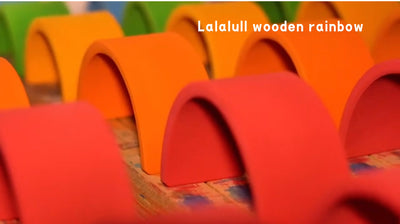Wooden Rainbow toys have become a staple in many households and educational settings, beloved for their simplicity, durability, and the endless opportunities they offer for creative play. But how did these vibrant toys come to be? In this blog post, we'll delve into the history and evolution of wooden rainbow toys, tracing their journey from traditional craftsmanship to modern-day playroom essentials.
1. Origins in Early Childhood Education
The concept of using wooden toys for educational purposes dates back to the 19th century. Friedrich Froebel, a German educator and the founder of the kindergarten movement, believed in the importance of play in early childhood development. He introduced "Froebel Gifts," a series of educational play materials made from natural materials, including wood. These gifts included building blocks and other geometric shapes designed to teach children about form, color, and spatial relationships.
2. Influence of Waldorf Education
The modern wooden rainbow toy can trace much of its inspiration to the Waldorf education philosophy, founded by Rudolf Steiner in the early 20th century. Waldorf education emphasizes the use of natural materials and open-ended toys that stimulate a child's imagination and creativity. Wooden Rainbow toys fit perfectly within this framework, offering endless possibilities for imaginative play without the constraints of predefined uses.
3. The Birth of the Classic Wooden Rainbow Stacker
The wooden rainbow stacker, as we know it today, was popularized by German toymaker Grimm's Spiel und Holz Design. Founded in the early 1970s, Grimm's has been dedicated to creating high-quality, handmade wooden toys that align with the principles of Waldorf education. Their iconic wooden rainbow stacker, with its vibrant colors and smooth arches, became an instant favorite among parents and educators alike.
4. Design and Craftsmanship
The design of wooden rainbow toys has remained relatively consistent over the years, characterized by their simple, elegant shapes and bright, non-toxic colors. The craftsmanship involved in making these toys is a significant part of their appeal. Many wooden rainbow toys are handmade by skilled artisans who carefully select the wood, cut and sand the pieces, and apply safe, eco-friendly finishes.
5. Global Popularity and Cultural Variations
While wooden rainbow toys have strong roots in European educational philosophies, their popularity has spread worldwide. In different cultures, these toys have taken on various forms and designs, reflecting local artistic traditions and educational values. For instance, in Japan, the traditional art of woodworking, known as "kumiki," involves creating intricate wooden puzzles and toys that emphasize problem-solving and fine motor skills.
6. Modern Adaptations and Innovations
In recent years, wooden rainbow toys have seen numerous adaptations and innovations to meet the evolving needs and preferences of children and parents. Contemporary designers have introduced new shapes, sizes, and colors, expanding the possibilities for creative play. Some variations include:
- Miniature Rainbow Stackers: Perfect for younger children or those with limited play space.
- Giant Rainbow Stackers: Larger versions that offer more opportunities for building and imaginative play.
- Monochromatic and Pastel Colors: Alternatives to the traditional rainbow palette, catering to different aesthetic preferences.
7. Sustainability and Eco-Friendliness
As awareness of environmental issues has grown, so too has the emphasis on sustainability in toy production. Wooden rainbow toys are celebrated for their eco-friendly attributes. They are typically made from sustainably sourced wood, and manufacturers often use non-toxic paints and finishes. This commitment to sustainability ensures that wooden rainbow toys are safe for children and kind to the planet.
8. Continued Educational Relevance
Despite the rise of digital and electronic toys, Wooden Rainbow toys remain relevant and cherished in modern educational contexts. Their open-ended nature encourages children to use their imagination, engage in problem-solving, and develop fine motor skills. Educators and parents alike continue to value these toys for their ability to foster holistic development in children.
Conclusion
The history and evolution of Wooden Rainbow toys highlight their enduring appeal and educational value. From their origins in early childhood education movements to their place in contemporary playrooms, these toys have stood the test of time. Their simplicity, durability, and versatility make them a timeless choice for parents and educators seeking to nurture creativity and learning in children. As we look to the future, it's clear that wooden rainbow toys will continue to play a significant role in the world of children's play and development






